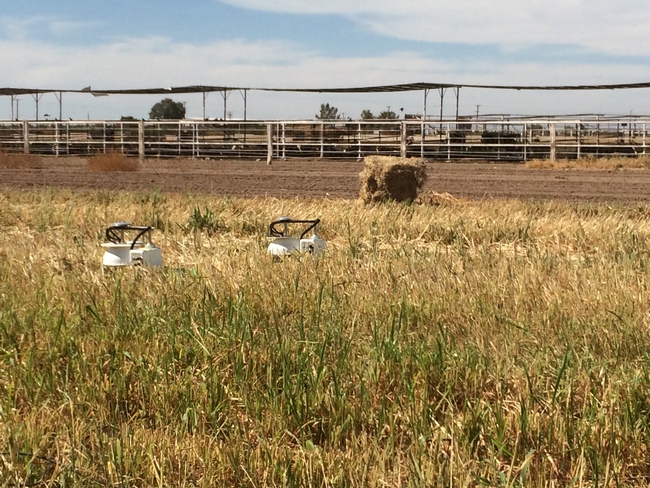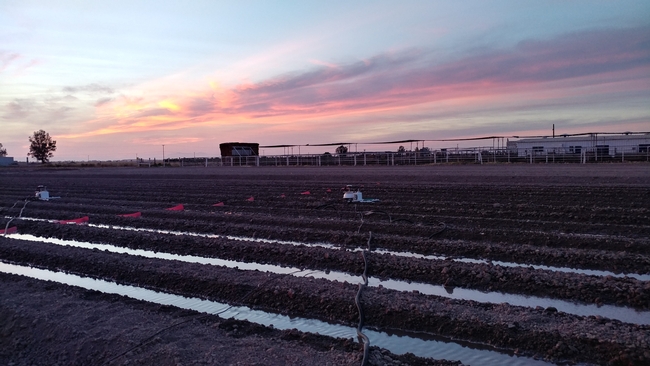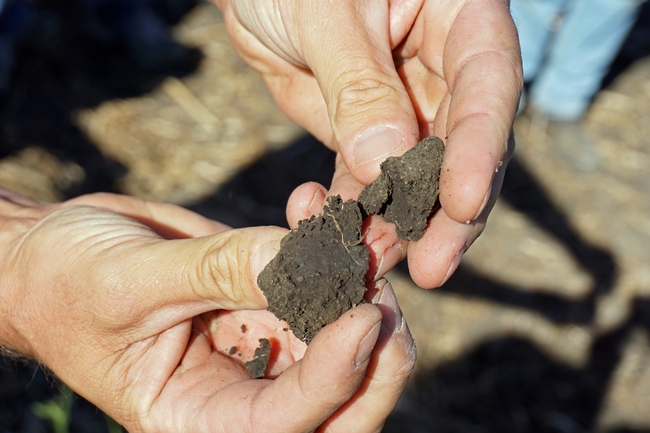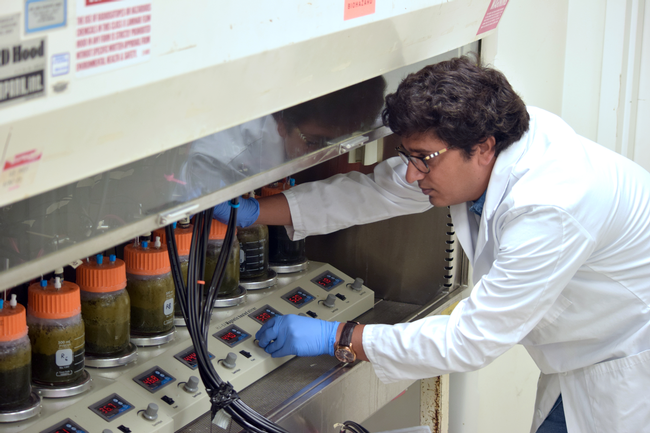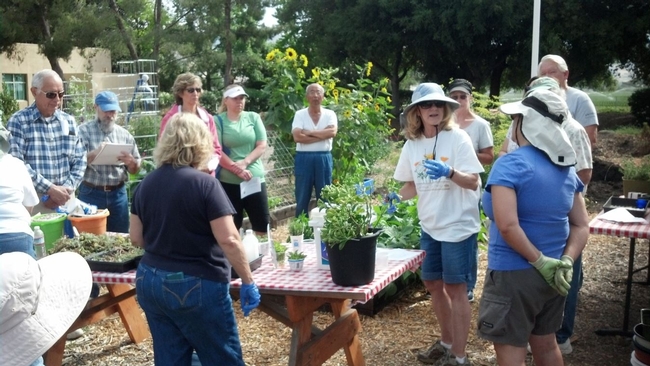Posts Tagged: greenhouse gas
Drip irrigation in arid regions can cut greenhouse gas emissions, improve air quality
Study at Desert Research and Extension Center highlights agriculture's sustainability role
Under the blistering sun of Southern California's Imperial Valley, it's not surprising that subsurface drip irrigation is more effective and efficient than furrow (or flood) irrigation, a practice in which up to 50% of water is lost to evaporation.
But a recent study also concludes that drip irrigation can dramatically reduce greenhouse gas emissions from soil – which contribute to climate change and unhealthy air quality in the region – without sacrificing yields of forage crops alfalfa and sudangrass.
“It was really exciting to see,” said lead author Holly Andrews, a National Science Foundation postdoctoral fellow at the University of Arizona. “The crop yield was at least maintained and in some cases increased, but the water use and gaseous emissions were especially decreased under drip irrigation.”
Desert REC crucial to collecting data
Andrews and her colleagues gathered data from field studies at University of California Agriculture and Natural Resources' Desert Research and Extension Center, a crucial hub of desert agriculture research for more than 100 years. Studies in that context are increasingly important, as much of California and the Southwest becomes hotter and drier.
“We already have this history of looking at drip irrigation at this site, so our study was trying to build on that,” said Andrews, who lauded Desert REC's facilities and staff.
In their study published in Agriculture, Ecosystems & Environment, researchers found that – in comparison to furrow irrigation – drip irrigation in alfalfa slashed per-yield soil carbon dioxide emissions by 59%, nitrous oxide by 38% and nitric oxide by 20%.
Nitrous oxide is a greenhouse gas with nearly 300 times more warming potential as carbon dioxide, and nitric oxide is a precursor to ozone and major contributor to air pollution.
While drip irrigation only decreased water demand 1% in alfalfa, the practice led to a substantial 49% decrease in irrigation for sudangrass. For more fertilizer-intensive sudangrass, drip irrigation also reduced soil emissions of nitrous oxide by 59% and nitric oxide by 49% – the result of drip irrigation making those fertilizers more efficient.
Water management can help mitigate climate change
Studying alfalfa and sudangrass – forage crops with very different fertilizer requirements – was a strategic choice by the researchers. They are number one and number three on the list of most widely grown crops by acreage in the Imperial Valley (Bermudagrass, another forage crop, is number two).
With so much land dedicated to producing these crops, the adoption of drip irrigation at scale could deliver significant benefits to residents' health and quality of life.
“The thought that saving water can increase yields while lowering the emission of trace gases that affect regional air quality and Earth's climate is quite encouraging,” said Pete Homyak, an assistant professor of environmental sciences at UC Riverside who contributed to the study. “This is especially true for the Imperial Valley, an arid region where water is a limited resource and where residents are exposed to bad air quality.”
Homyak, who is affiliated with UC ANR through UC Riverside's Agricultural Experiment Station, said that this study illustrates how changes in water management can substantially mitigate agricultural impacts on the environment.
The study findings should encourage growers to replace furrow irrigation systems with drip irrigation infrastructure – especially in combination with financial incentives from the state, such as cap-and-trade and carbon credit programs, that can help defray high installation costs.
“It really is worthwhile if you're thinking sustainability and environmental activism in how agriculture can actually support climate change mitigation,” Andrews explained. “These practices might be a way that we can start to change that picture a little bit – and make agriculture more sustainable by tailoring irrigation management to local climate conditions.”
In addition to Andrews and Homyak, the other study authors are Patty Oikawa, California State University, East Bay; Jun Wang, University of Iowa; and Darrel Jenerette, UC Riverside.
UC Cooperative Extension to investigate healthy soil practices with CDFA grants
Six UC Cooperative Extension research projects were awarded funding ranging from $100,000 to $250,000 each from the California Department of Food and Agriculture Healthy Soils Program. The grants are designed to fund implementation and demonstration of on-farm soil health practices that reduce greenhouse gas emissions and store carbon.
One of the grant recipients, John Bailey, director of the UC Hopland Research and Extension Center in Mendocino County, will use the $100,000 award to establish a perennial hedgerow at the center. Hedgerows are not traditionally part of standard ranching practices in Mendocino County, where in the past the center's 5,400 acres of rangeland and surrounding areas were grazed by large flocks of sheep.
“At Hopland, we have pivoted our operation to reflect the current state of the sheep industry in California, with reduced overall sheep numbers and decreased individual flock size, so we will use this project to show our smaller-scale sheep owners how they can enhance the ecosystems of their properties,” Bailey said.
Bailey expects the hedgerow to offer many educational, ecological and practical benefits, including enhancing soil health, increasing soil carbon sequestration, and providing habitat and food sources for beneficial organisms, such as pollinators and birds.
There may also be economic benefits to using sustainable practices in raising sheep. The project will explore the financial costs of implementing hedgerows as well as the opportunity for producers to enter a niche fiber market by offering sustainably produced wool to textile companies and consumers willing to pay a premium to support the ecological benefits of Healthy Soil Projects.
“I'm excited about this opportunity to combine the latest knowledge on environmental sustainability practices with the older traditions of livestock grazing in Northern California,” Bailey said. “This is a progressive step that ties in ecological knowledge that can benefit the livestock ranching model by both enhancing their properties and creating new markets for their products.”
The following projects were also funded by CDFA Healthy Soils Program in 2020:
Integrated sustainable nitrogen management in vegetable cropping systems, $250,000
Maria de la Fuente, UCCE county director and advisor, Monterey and Santa Cruz counties
The implementation of climate-smart agricultural practices within intensively managed vegetable cropping systems is extraordinarily challenging. Often conservation practices cannot be effectively implemented due to operational barriers, resulting in very low rates of adoption.
By demonstrating nutrient management strategies in partnership with a large influential vegetable grower in the Salinas Valley, the project aims to encourage broad scale practice adoption.
Recent research has indicated the addition of organic amendments in combination with nitrogen fertilizers potentially reduces nitrogen-derived greenhouse gas emissions and nitrate leaching while increasing soil carbon stocks. These outcomes will generate significant climate benefits in agroecosystems experiencing heavy tillage and fertilizer inputs.
This project has the potential for statewide impact as the researchers are currently working with the developers of COMET-Farm to provide data and coordinate outreach within vegetable cropping systems. Through direct engagement the team will make integrated sustainable nitrogen management more feasible and agronomically favorable for producers.
Using hands-on COMET-Farm-focused field days and a webcasted sustainable nitrogen short course, the project will provide producers with additional tools to make nutrient management planning decisions that have positive climate and soil health outcomes.
Evaluation of compost application to processing tomato fields in the Sacramento Valley, $100,000
Amber Vinchesi-Vahl, UCCE vegetable crops advisor, Colusa, Sutter and Yuba counties
The project will demonstrate compost applications on two farms in two Sacramento Valley counties, Colusa and Sutter. The researchers will work with Westside Spreading LLC and compare two plant-based compost rates to a control (no compost) over three years. Soil health parameters – such as total carbon and nitrogen, pH, EC, organic matter and fertility analyses relevant to tomato crop production – will be measured.
The benefits of compost applications vary depending on how often they are used, how much is applied, crop rotation, and other management decisions, such as whether compost is incorporated or left on the soil surface. Vinchesi-Vahl expects that over time the compost implementation evaluated in this project will result in lower input costs and improved soil function.
Compost application may reduce the need for fertilizer inputs for some of the rotational crops and provide benefits to the microbial community, thereby improving soil structure and reducing heavy conventional tillage needs.
By improving soil health, the research expects plant health will also be improved, leading to better tolerance to pest pressure from diseases and weed competition.
The two demonstration sites will showcase compost applications and their impact on processing tomato production and annual production soil health. These focused demonstrations will be extremely important in showcasing this soil health practice in the local Sacramento Valley region, providing information to growers from the experiences of collaborators at the two sites.
Evaluation of winter cover crop species for their ability to mitigate soil compaction in an annual rotation, $100,000
Sara Light, UCCE agronomy advisor, Sutter, Yuba and Colusa counties
This project has three components:
- Replicated research plots in which three cover crop varieties are evaluated for improvements in soil structure, specifically subsurface soil compaction
- Fieldscale demonstration plots in which varieties thought to reduce soil compaction are planted and visually assessed for performance in the Sacramento Valley
- Small, single-row hand planted plots in the buffer area, in which a wider number of both summer and winter cover crop varieties will be planted for outreach and demonstration purposes
Combined, these components will enable growers to make more informed decisions about cover crop selection and encourage wider adoption of cover cropping. The outreach objective for this project is to reduce barriers to cover crop adaption among regional growers by increasing knowledge and information about varietal selection and field-scale cover crop management, as well as opportunities to improve soil structure using cover crops.
Healthy soils demonstration project with Cardoza Farm, $100,000
Ruth Dahlquist-Willard, UCCE small farms advisor, Fresno and Tulare counties
This project will demonstrate compost application, hedgerow planting, and application of mulch generated from cover crop residue in a vineyard producing organic raisin grapes. Mulch will be applied directly under the vines, providing ground cover that will conserve soil moisture and decrease weed pressure. Generating the mulch on-farm eliminates the need to transport materials from outside sources.
Currently, production of organic raisin grapes involves frequent tillage under the vines. The cover crop between rows and the mulch under the vines will reduce the need for tillage for weed control and increase soil organic matter. These practices will be showcased at field days that will include bilingual training for small-scale, socially disadvantaged farmers in the San Joaquin Valley.
Application of compost to alfalfa to improve soil structure and fertility, $250,000
Kate Scow and Radomir Schmidt, UC Davis Department Land, Air, Water Resources and UCCE advisors Michelle Leinfelder-Miles and Rachael Long
This project will demonstrate compost application to alfalfa for improving soil structure and fertility. Compost is not typically applied to alfalfa; however, manure application to alfalfa is common in the state's dairy regions.
The over half a million acres of alfalfa in California could represent an important repository for compost, for which a large land base of spreading may be needed as municipalities convert organic waste management streams to diversion from landfills.
Alfalfa has the ability to immobilize large amounts of nitrogen and phosphorus, nutrients of concern in the concentration of organic wastes due to their potential to contribute to water pollution. Furthermore, alfalfa growers are interested in the potential of compost to improve soil structure in their alfalfa fields, as many growers report suffering from the large cracks that form in soils during the wet-dry cycles of alfalfa surface irrigation management.
Compost application has been anecdotally reported to alleviate soil cracking in another perennial crop, almond orchards in the Central Valley, but soil structure improvement via management practices like compost application has received little research attention thus far. Westside Spreading LLC is collaborating on this project.
Innovating dairy digester research
California leads the nation in agricultural production, producing nearly all the nation's leafy green vegetables, most nut and fruit varieties, and is ranked first in egg and dairy production.
What that means is that California also produces a lot of agricultural waste materials, including lots of manure.
Historically these waste materials have been used as a rich source of compost. However, researchers at UC Cooperative Extension are researching innovative uses for this material.
Dr. Pramod Pandey, a faculty member and Cooperative Extension specialist at the UC Davis School of Veterinary Medicine, focuses on better ways to manage waste material for both large and small farms. Dr. Pandey researches how to convert the organic matter in manure and other waste materials into a renewable energy source that can be used to power our state.
Converting manure to renewable energy
California gets over 27% of its energy from renewable resources like solar wind, and hydroelectric. Our goal is 50% renewable energy by 2030. California is taking steps towards this goal by building a network of dairy digesters which use bacteria to break down dairy manure and convert it into biogas. Clean burning fuels, such as biogas, are a sustainable source for generating energy because when they are burned, harmful by products are not produced.
Big bonus
A bonus is that the solid material left after the digesters have done their job is a fertilizer that can be used to grow the fruits, vegetables and nuts that our state is famous for. This type of fertilizer contains nutrients that are more readily available for plants because the digestion process breaks up organic materials more efficiently than traditional composting. The digestion process also helps reduce the number of harmful bacteria found in manure, making it much safer for use on plants grown for human food.
California leading in discovery and innovation
When we think about where agriculture has been and where it is going, innovation, efficiency and environmental sustainability are hallmarks of our approach in California. People like Dr. Pandey are driving forward research and technology to minimize the impact of agriculture production on the environment. When we think about where agriculture has been and where it is going, innovation, efficiency and environmental sustainability are hallmarks of our approach in California. His multidisciplinary approach to solving this complex problem of agricultural waste materials and water/air quality helps improve the economic wellbeing of farmers, and benefits Californians by providing nutrients for safe, healthy, and nutritious food.
While the importance of California's agriculture might be huge, its footprint on the environment doesn't have to be, and it is researchers like Dr. Pramod Pandey who are ensuring our state leads in discovery and innovation for many harvests to come.
Heather Johnson, Instructional Systems Designer, Gregory Wlasiuk, E-Learning Curriculum Designer, and Dr. Sara Garcia, Project Scientist, with the Western Institute for Food Safety and Security at the University of California, Davis, provided the script for the video which was used in this story. View Heather, Sara and Greg's filming and editing skills in the video below. Greg provides the narration.
A home garden can help reduce greenhouse gas emissions
A UC Santa Barbara study concluded that planting a home garden can cut carbon emissions to the atmosphere. However, if gardening isn't done right, it could actually contribute to greenhouse gas emissions, reported Nathanael Johnson on Grist.org.
The article looked at five factors that impacted greenhouse gas emissions in home gardens:
- Reduction of lawn area due to replacement by the garden
- Reduction of vegetables purchased from the grocery store
- Reduction in the amount of greywater sent to treatment facilities due to diversion to irrigate the garden
- Reduction in amount of household organic waste exported to treatment facilities due to home composting
- Organic household waste is composted for use in the garden
The abstract of the research article, written by David Cleveland, sustainable food systems professor in the Department of Geography, said:
"We found that (gardens) could reduce emissions by over 2 kg CO2e kg−1 vegetable, but that results were sensitive to the range of values for the key variables of yield and alternative methods for processing household organic waste."
In his Grist story, Johnson provided key points from the research that can help ensure the home garden is climate smart:
- The main reduction from gardening comes from diverting food waste from the landfill, where it rots and emits methane and nitrous oxide. Food waste must be properly composted to prevent the emissions.
- Planting a garden then forgetting about it ends up emitting more greenhouse gases than if you never started.
The article suggests that Californians contact their local UC Master Gardener program for assistance in properly managing a home vegetable garden. Johnson spoke to Kerrie Reid, the UC Cooperative Extension environmental horticulture advisor in San Joaquin County.
"Reid doesn't abandon her plants midway through summer, and she doesn't over-plant and then end up throwing out dozens of thigh-thick zucchinis," Johnson wrote. "Sure, when the cucumbers peak, there are more than she and her husband can eat, she confesses, but they share with their neighbors. The neighbors also come over to harvest herbs from the sidewalk."
The article said readers can find their own version of Reid by looking up a local UC Cooperative Extension Master Gardener program.
San Joaquin Valley row crop growers help control greenhouse gases
Taylor interviewed lead researcher Jeff Mitchell, UC ANR Cooperative Extension specialist and chair of the UC ANR Conservation Agriculture Systems Innovation Center.
Long-term research by UC ANR has documented the capacity for farmland in the San Joaquin Valley managed with certain conservation practices to sequester carbon, results that could give farmers a seat at the carbon trading table, the article said. The study was published this month in the Agronomy Journal.
"We're reducing the atmospheric load of carbon dioxide, a greenhouse gas that plays an important role in global warming," Mitchell said. "Proving a stable storage location for carbon could allow agriculture to be part of future cap-and-trade programs."
The ANR news release on the research was also picked up by the Central Valley Business Times, California Political Review and the Red Bluff Daily News.
Click here to listen to Doug Cooper of AgLife radio interview Mitchell about the research.

